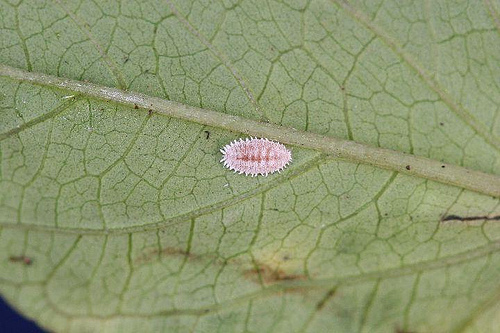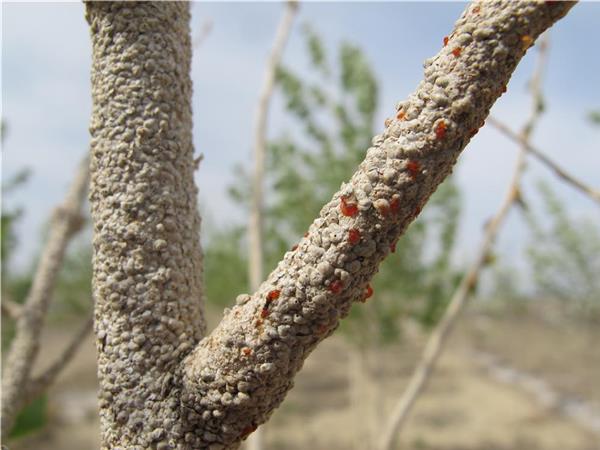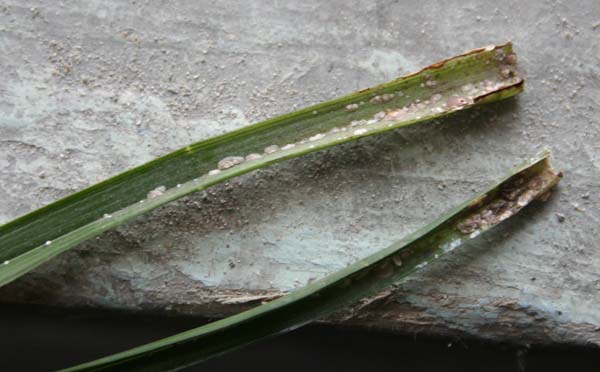What are the common shell pests and their control methods
The harm of shell insects to plants is relatively great, they are distributed in groups on the stems and leaves of plants, which not only affect the ornamental effect of plants, but also gnaw on the branches and leaves of plants, causing large area damage to plants.

1. Common shell pests
1. Ceroplastes. Also known as straw sandals shell insects, persimmon naked scale. It mainly harms many kinds of fruit trees such as peach, persimmon, pear, apple and garden ornamental plants such as cherry blossom, magnolia, wax plum, rose, rose, locust and so on. The female adult has an oval body, 8-10 mm long and 4-5 mm wide, with a grayish purple back and a yellowish periphery, shaped like straw sandals, covered with a layer of fine hair and white wax powder. The nymph is similar in shape and reddish brown.
2. Japanese tortoise wax scale. It has a wide range of hosts, including crape myrtle, magnolia, sweet-scented osmanthus, oleander, rose, peony and other ornamental plants, as well as peach, plum, jujube, loquat, apricot, Hawthorn, apple, pear, fig and other fruit trees. The adult wax shell is flat-oval, white, 3-4.5 mm long, and the dorsal part is tortoise shell-shaped concave. The living worm is light brown to purplish red, the nymph is light reddish brown when hatched, begins to secrete wax after 1 day, and forms a wax shell in 7-10 days.
3. Brown soft scale. More harm to household flowers, such as orchids, evergreen, Milan, cyclamen, tortoise back bamboo, jasmine, calla lilies, cycads and so on more than 170 kinds of plants. Female adults often parasitize along the midvein on the opposite side of the leaves; the body is ovate, 2-4 mm long, and the body color varies greatly, often yellowish green, yellowish brown or reddish brown. There is a longitudinal ridge uplift in the center of the back, dark brown around the ridge, often with black spots scattered or integrated patches, forming two brown reticular transverse bands.

II. Methods of pollution-free control of shell insects
1. Mix liquor with water at 1:2. When controlling insects, water through the surface of the basin soil. Scale insects begin to move when the room temperature is 7 ℃ in spring. It can be watered once in April, and then every half a month or so, and it has been effective for 4 times in a row.
2. After soaking small cotton balls in vinegar with 50 ml of vinegar, gently wipe the damaged stems and leaves with wet cotton balls to wipe off the shell insects. This method is convenient and safe, which can not only achieve the purpose of disinfestation, but also make the damaged leaves green and shiny again.
3. If you wipe the diseased plant gently and repeatedly with sprinkling essence, you can get rid of the shell worm, and it can be very clean and thorough. For example, when spraying essence is used to wipe the diseased leaves of orchids, not only the shell insects can be removed, but also the larvae that are not visible to the naked eye can be completely killed, and the harm of shell insects is rarely found in the second year. This method is simple, safe and effective.
4. Diesel oil, washing powder and water are adjusted into mother liquor according to the ratio of 10 to 0.6. At this time, the mother liquor contains 60%, which is in the shape of milk. After diluting 30% of the liquid containing oil with water, carefully spray the insect on Milan, kumquat and cycad. After a week, most of the scale insects changed from fresh orange to withered state, indicating that this method has a good control effect on scale insects.

3. Control methods of shell pests in garden plants.
The main results are as follows: 1. Quarantine measures: scale insects are inactive or inactive, and their own transmission capacity is limited, but they are easy to spread with the transportation and exchange of seedlings. So quarantine is particularly important.
2. cultivation techniques to prevent and control proper rotation; thoroughly clean up the residual branches and leaves in the nursery; reasonable thinning, ventilation and light transmission; pruning insect branches and concentrated burning; manual and mechanical removal with soft brushes, or killing with rags dipped in kerosene.
3. When a large number of chemical control occurs, 10-15 times turpentine mixture can be sprayed once in winter to eliminate the overwintering female; before sprouting in spring, the overwintering generation larvae can be eliminated by spraying 3-5 Baomei stone sulfur mixture; newly hatched larvae, spraying insecticides such as carbaryl and phoxim on the soil around the roots in early spring, and nymphs on the tree can be sprayed with omethoate, malathion, dichlorvos, fenitrothion and so on.
4. Protect natural enemies, protect some ladybugs, aphid wasps, jumping wasps and so on.

Generally speaking, any plant diseases and insect pests should be based on prevention, and then the combination of prevention and control, so that it will have a better effect. In addition, although the ants themselves can catch and eat some shell insects, the ants themselves also pose a threat to plants, so ants are not recommended in the protection of biological natural enemies.
Related
- Wuhan Hospital Iron Tree Blooming Result Was Instantly Frightened by the Gardener Master
- Which variety of camellia is the most fragrant and best? Which one do you like best?
- What is the small blue coat, the breeding methods and matters needing attention of the succulent plant
- Dormancy time and maintenance management of succulent plants during dormancy
- Minas succulent how to raise, Minas succulent plant pictures
- What are the varieties of winter succulent plants
- How to raise succulent plants in twelve rolls? let's take a look at some experience of breeding twelve rolls.
- Attention should be paid to water control for succulent plants during dormant period (winter and summer)
- Watering experience of twelve rolls of succulent plants
- Techniques for fertilizing succulent plants. An article will let you know how to fertilize succulent plants.



